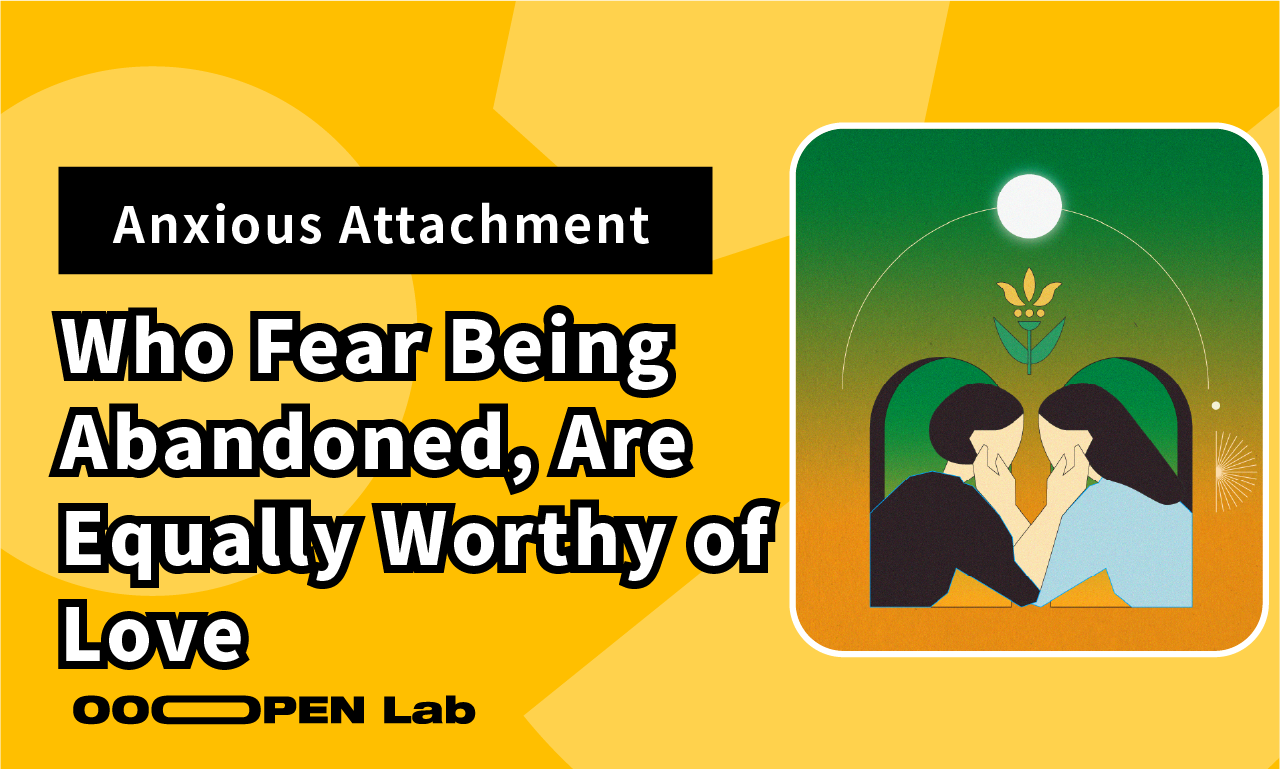- What is Anxious Attachment?
- How Does Anxious Attachment Develop?
- The Feelings of Those with Anxious Attachment
- Challenges Faced by Individuals with Anxious Attachment
- The Advantages of Anxious Attachment
- Seven Ways to Improve Anxious Attachment
- How to Interact with Someone with an Anxious Attachment Style
What is Anxious Attachment?
Anxious attachment is a form of insecure attachment in attachment theory. It refers to a heightened sense of anxiety experienced by children when separated from their primary caregivers (often their parents), a feeling also known as separation anxiety.
“In Ainsworth’s Strange Situation paradigm, infants classified as anxious-ambivalent or resistant (Type C) exhibit significant distress upon separation from their caregiver. Upon reunion, they display ambivalent behavior, simultaneously seeking contact and resisting soothing attempts, often appearing angry or passively helpless, reflecting their uncertainty about caregiver availability.”
Ainsworth, M. D. S., Blehar, M. C., Waters, E., & Wall, S. (1978). Patterns of attachment: A psychological study of the strange situation. Lawrence Erlbaum Associates.
This anxiety can cause significant distress for the child and, in severe cases, may even interfere with daily life.
Research suggests that approximately 10% of children exhibit anxious attachment.
Children with this attachment style experience intense insecurity when their caregivers are not around, leading to feelings of anxiety, frustration, or even anger. However, even when the caregiver is present, these children often struggle to feel truly secure.
When faced with complex emotions, they may have difficulty regulating their thoughts, repeatedly asking themselves questions like:
• “Why is my mom/dad treating me this way?”
• “Did I do something wrong?”
Because these emotions are so overwhelming, children develop coping behaviors to manage their distress.
For instance, they may:
• Repeatedly ask questions (Where are you going? When will you be back?)
• Seek constant reassurance (Needing others to repeatedly promise they will follow through on something)
How Does Anxious Attachment Develop?
“The development of an anxious/ambivalent attachment pattern is often linked to inconsistent caregiver responsiveness. Caregivers may be available and attentive on some occasions but unavailable, intrusive, or rejecting on others. This unpredictability makes it difficult for the child to develop confidence in the caregiver’s availability, fostering chronic vigilance and uncertainty.”
Cassidy, J., & Berlin, L. J. (1994). The insecure/ambivalent pattern of attachment: Theory and research. Child Development, 65(4), 971–991.
A child typically develops an anxious attachment style due to inconsistent caregiving from their caregivers.
This inconsistency might manifest as parents being warm and affectionate one moment, only to suddenly become distant or indifferent the next. It could also involve caregivers failing to respond to the child’s needs—such as lacking eye contact, verbal affirmations, or even simple vocal responses.
Faced with such unpredictable reactions, children begin to experience confusion and fear.
In an attempt to make sense of the situation, they may start to believe, “Am I not good enough?” or “Will I be abandoned at any moment?”
Over time, this leads to a conflicted perception of receiving care.
This internal conflict fosters a sense of self-doubt, making it difficult for them to believe in their own worth and that they are deserving of love.
On one hand, they deeply crave love because being loved reassures them of their value. On the other hand, they fear that seeking love might lead to rejection.
This lack of trust fuels a bottomless pit of anxiety—constantly making them feel insecure, yet offering no clear way to alleviate those feelings.
The Feelings of Those with Anxious Attachment
People with anxious attachment commonly experience intense anxiety and discomfort when separated from their caregivers or loved ones.
The anxiety they face is not just occasional nervousness or fear that anyone might experience in daily life. Instead, these feelings cling to them persistently, and unlike ordinary discomfort that fades over time, their anxiety tends to persist and may even worsen.
Beyond emotional distress, they may also exhibit physical symptoms such as dry mouth, trembling hands, rapid heartbeat, and chest tightness.
These anxiety symptoms can lead to catastrophic thinking, also known as obsessive thoughts (obsessions)—a mental state where their mind spirals into relentless worst-case scenarios.
To stop these overwhelming emotions and thoughts, they often engage in compulsive behaviors (compulsions), such as constantly seeking reassurance from others or frantically trying to contact their loved ones immediately.
“Individuals with high attachment anxiety tend to employ ‘hyperactivating strategies’ when feeling insecure or threatened. These involve exaggerating distress signals, persistent efforts to gain attention and care, rumination on relationship threats, and heightened sensitivity to cues of rejection or abandonment, all aimed at maximizing proximity to attachment figures.”
Mikulincer, M., & Shaver, P. R. (2007). Attachment in Adulthood: Structure, Dynamics, and Change. Guilford Press. (Summarizing hyperactivating strategies).
However, these actions provide only momentary relief, making them feel “better for a second,” before their anxiety resurfaces again, often even more intensely.
This forms a vicious cycle, where compulsive behaviors become the only means they believe can bring them a sense of control and relief—yet, paradoxically, they only end up feeling more distressed over time.
Challenges Faced by Individuals with Anxious Attachment
People with anxious attachment tend to have low self-esteem and a negative self-concept. They often measure their self-worth based on the relationships they value.
However, their thoughts and behaviors surrounding relationships—while deeply significant to them—can sometimes create pressure, both for themselves and for others.
Individuals with anxious attachment struggle to believe that they are inherently lovable and valuable. When they don’t feel a strong connection with others, they may experience a sense of abandonment, fearing that they are unwanted.
For them, relationships equate to self-worth—if a relationship “falls apart,” it can feel like a confirmation that they are not good enough or unworthy of love.
Under this immense pressure, they prioritize relationships above all else. When conflicts arise, they tend to take an intensely proactive approach to resolve issues. However, their actions may sometimes come across as overwhelming or intrusive—for instance, constantly checking in on their partner, needing frequent reassurance of love, or excessively worrying that their partner may develop feelings for someone else.
Because of these behaviors, people with anxious attachment may be perceived as emotionally volatile, struggling with emotional regulation, or having difficulty trusting others. In reality, these behaviors stem from an intense fear of emotional devastation—as if their world is on the verge of collapse.
Some individuals may even recognize that their actions are excessive or burdensome to those they care about. Yet, the overwhelming fear of abandonment makes it difficult for them to stop. As a result, they may become trapped in guilt, feeling remorseful for their behavior but unable to break free from their deep-seated anxiety.
The Advantages of Anxious Attachment
Although anxiety often brings discomfort, it is actually an instinctive response developed to adapt to an unstable external environment. Because of this, it has its reasons for existing and even some benefits.
1. Anxiety Develops as a Coping Mechanism in Childhood
As mentioned earlier, anxious attachment forms as a response to inconsistent caregiving—when a caregiver is warm and attentive at times but distant or unresponsive at others.
The emotional wounds caused by such an environment can be deep, but in order to survive and form relationships like everyone else, children develop this attachment style as a temporary way to adapt.
However, as they grow up, the strategies that once helped them cope may no longer be as effective, leading to difficulties in relationships. But it’s important to recognize that this attachment pattern was originally an effort to maintain relationships and ensure survival. At the time, it was the best possible approach for them.
2. Heightened Sensitivity to Others’ Emotions and Feelings
Because they deeply care about their relationships, people with anxious attachment tend to be highly sensitive to others’ emotions and changes in mood.
They fear being ignored, so in turn, they rarely overlook the emotions of those around them.
3. A Strong Sense of Trust in Others
At first glance, people with anxious attachment may seem distrustful—constantly questioning whether their partner truly loves them. This might appear to contradict the idea of trust.
However, the truth is that they often struggle with self-trust, rather than a lack of trust in others. In fact, they deeply believe in others, particularly in their ability to provide the stability and security they crave.
Although their underlying belief that they are “unworthy of love” fuels their insecurity, it also signifies that they highly value the relationship they are in.
4. Dedication to Relationships and Strong Effort in Maintaining Connections
For people with anxious attachment, relationships are closely tied to their sense of self-worth. As a result, they invest a great deal of energy into maintaining and strengthening their bonds with loved ones.
They often appear to be the ones who put in extra effort—initiating contact, checking in on their partner, and showing consistent care and concern. Their proactive approach to relationships reflects their deep desire for emotional connection and security.
Seven Ways to Improve Anxious Attachment
Individuals with an anxious attachment style often struggle with feelings of insecurity, particularly in relationships. When a relationship ends, they may feel as though their entire world is collapsing and that they are left with nothing.
The key to improving anxious attachment lies in building personal security and understanding how to support oneself in moments of insecurity. Here are seven ways to do just that:
1. Don’t Accept Others’ Opinions Unquestioningly
When forming self-perceptions, people often take others’ evaluations into account. You might wonder:
• How do important people see me?
• Do I meet societal expectations?
While considering external perspectives is natural, it’s crucial to remember that everyone has their own value system. Blindly accepting others’ opinions can lead to self-doubt and missed opportunities for self-discovery.
Instead of internalizing every critique, focus on identifying neutral and constructive feedback. When listening to others, look out for emotionally charged words like bad, terrible, awful, or worthless—these often reflect personal biases rather than objective truth. When you notice such language, take a moment to question whether the judgment is valid.
2. Recognize Your Efforts and Value
People with anxious attachment often lack self-confidence and struggle to see their own strengths or worthiness of love. It may feel difficult to believe that everyone is unique and valuable, but this mindset can be cultivated through practice.
A helpful technique is positive reframing—instead of thinking “I only did…”, try “I already accomplished…”. By shifting your focus to what you have achieved, rather than what you lack, you begin to see your own competence.
When setting goals, ensure they are specific and achievable. Instead of saying, “I don’t want to waste time before bed anymore,” reframe it as, “I will read a book for 30 minutes before bed.”
Concrete, actionable goals increase the likelihood of success, providing a sense of accomplishment rather than reinforcing feelings of failure.
3. Create Positive Experiences
Positive experiences, particularly those that involve emotional connection with others, not only create happy memories but also help build self-confidence.
To cultivate positive experiences, engage in enjoyable activities—especially those you excel at or find fulfilling. Whether it’s sports, reading, playing an instrument, or gardening, investing in hobbies can bring satisfaction and a sense of achievement.
If you don’t have a hobby yet, try experimenting with new activities. Watch tutorial videos to learn a new skill, attend an interesting seminar, or explore social events. Developing personal interests not only provides relaxation but also strengthens self-worth and enriches life experiences.
4. Take a Balanced Perspective on Situations
People with anxious attachment tend to interpret situations negatively. However, every event has multiple perspectives.
A practical exercise is journaling thoughts when feeling upset or uncomfortable. Use a notebook, phone memo, or voice recording to document the situation and your thoughts.
After writing it down, look for evidence that both supports and contradicts your thought.
For example, if someone doesn’t reply to your message, your immediate reaction might be:
“Do they dislike me?”
• Supporting evidence: I might have done something that upset them a few days ago.
• Contradicting evidence: They are at work right now; they responded normally just a few hours ago.
By analyzing multiple perspectives, you can interrupt negative thought cycles and gain a more balanced outlook. Additionally, ask yourself:
“If my friend or family member were in this situation, how would they see it?”
This mental shift helps reduce anxiety and prevents self-blame.
5. Recognize and Address Your Anxiety
In addition to feeling emotionally tense, anxiety often manifests in physical symptoms such as dry mouth, shaky hands, rapid heartbeat, or chest tightness.
When experiencing these sensations in a relationship, try mentally telling yourself “Stop.” Pause and reflect:
• What am I worried about?
• Am I afraid of being betrayed?
• Do I fear not being good enough?
• Am I worried that my partner no longer loves me?
Then, ask yourself:
“Is my fear truly related to what’s happening right now?”
Often, we react based on past painful experiences rather than the present moment. If you’re unsure what is triggering your anxiety, step away from the situation and shift your focus. Engage in a simple, low-stress activity—such as cleaning—rather than ruminating.
Ruminating (replaying a situation in your mind) usually worsens anxiety and self-doubt. Instead, give yourself space to breathe and identify the root cause of your fears.
6. Understand That Relationships Involve Two People
A relationship is the result of two people’s interactions. Recognizing that no single person has full control over a relationship is an important step in overcoming anxious attachment.
When a relationship fails, it’s rarely due to one person’s shortcomings or actions alone. Relationships are like a game of catch—if one person throws a ball but the other doesn’t catch it, the game stops.
The ball may drop due to various reasons:
• The thrower’s technique
• The catcher’s readiness
• External factors like wind
• A lack of willingness from either party
It’s not just about one person being “not good enough” or “unlovable.” Instead, relationship outcomes are shaped by mutual interaction and circumstances.
While relationships can offer insight into oneself, they are not self-reflective exercises—they involve another unique individual with their own thoughts and feelings.
You can work on personal growth and security, but at the same time, it’s crucial to remember that relationships are a two-way street.
7. Consider Talking to a Therapist
If you find yourself repeatedly struggling with the same relationship patterns and feeling lost, seeking therapy can be a helpful step.
A therapist can help you recognize interaction patterns, offering new insights into your behavior in relationships. Therapy also provides a corrective emotional experience, where you feel accepted and supported—something that can gradually reshape your outlook on relationships.
By carrying this positive emotional experience forward, you’ll be better equipped to navigate future relationships with confidence and resilience.
How to Interact with Someone with an Anxious Attachment Style
Establish Emotional Boundaries
Emotional boundaries help us create a safe psychological space, distinguishing between our own emotions and those of others.
When we lack emotional boundaries, we can easily be influenced by our partner’s emotions, mistakenly believing that their feelings are our own.
For example, when an anxiously attached partner experiences anxiety, many people might think: Are they feeling this way because of me?
When we assume responsibility for our partner’s emotions, we may develop feelings of guilt. Over time, this guilt can accumulate and negatively impact both ourselves and the relationship.
In many Asian cultures, we are often conditioned to take responsibility for others’ feelings. However, as mentioned earlier, we cannot always know what others are thinking or what motivates them. Their emotions are their own and are not something we can control.
This means that each person is responsible for their own feelings. Recognizing this is not selfish—it is an acknowledgment that both partners have the ability to manage their own emotions and make their own decisions.
Once you have expressed care and concern for your partner through words or actions, the next step is for both of you to take responsibility for your own emotions.
Try establishing your own emotional boundaries!
Understand Your Own and Your Partner’s Needs
Everyone has their own desires and expectations in a relationship. If your partner has an anxious attachment style, they may crave a strong sense of security. This is where communication becomes essential.
People with an anxious attachment style often need reassurance about their partner’s thoughts and feelings. Taking the time to sit down and openly discuss emotions can be a powerful way to provide them with a sense of security.
However, don’t forget about yourself—what do you need?
Relationships are the result of mutual interaction. While it’s important to empathize with your partner and make them feel loved, you should also reflect on what a comfortable and healthy relationship looks like for you.
By paying attention to and caring for each other’s feelings, maintaining a balanced dynamic, and understanding each other’s love languages, you can build a stronger, more fulfilling relationship—one that allows both of you to truly experience the beauty of love.
Mindy
Master’s Degree in Clinical Psychology, Licensed Clinical Psychologist (License No. 2802).
Mindy has completed clinical training in psychiatric and child mental health departments in hospitals. She specializes in psychodynamic therapy, psychodrama, and cognitive behavioral therapy (CBT). Passionate about promoting psychological knowledge, she serves as a psychology content consultant and mental health seminar speaker.




